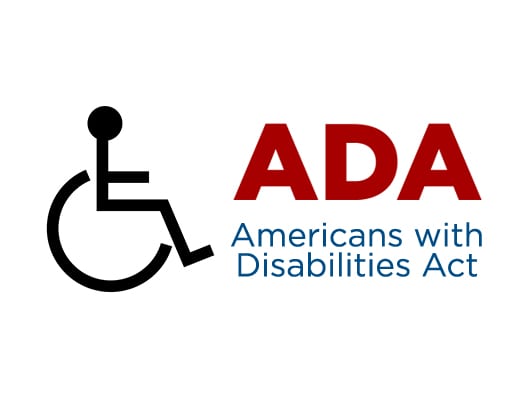ADA Compliance for Websites... All You Need to Know
Posted on July 09, 2019
By Michael Miller, Digital Media Designer

Americans with Disabilities Act (ADA)
ADA stands for Americans with Disabilities Act (ADA) and was signed into Federal law in 1990 under President George H.W. Bush. Its purpose was to ensure that people with a variety of disabilities can enjoy and participate in many of the same life experiences that ordinary citizens enjoy (from work opportunities to all types of consumer goods and services.)
ADA and website compliance
As technology has progressed and, by extension, affected our lives, it’s to be expected that ADA compliance guidelines would also keep up with the advancements in technology. We are now immersed in an online digital world in almost everything we do, with websites and apps being our primary everyday tools. A new ruling was recently passed that sets guidelines for making Websites and their consumer-driven contents equally as accessible to those with disabilities.
The three grade levels of compliance (A, AA, AAA)
There are three established levels (or grades) of compliance that are determined for any website that is submitted for analysis, to see how well it conforms to legal guidelines. These three standard levels (Web Content Accessibility Guidelines, or WCAG) are based on a set of criteria called Success Criteria and are as follows:
-
Level A conformance
This is the lowest level of compliance and covers the most basic needs for most disabilities, including providing text alternatives for non-text and mostly visual-based content, alternatives for prerecorded video and/or audio only content, captions for prerecorded content/videos that use sound, and providing any extra information (i.e., movements) in prerecorded videos where there is no audio.
-
Level AA conformance
This is the mid-level conformance standard that most average businesses ideally want to meet. In addition to the partial list of features explained above for Level A, it also includes things like captions for live video feeds, less color contrasts, options to resize text to 200%, limiting of text in image format, and all elements in content (i.e., headings, body copy) are labeled.
-
Level AAA conformance
This is the highest and most comprehensive level of conformance, where all standards are met. At the same time, when you conform this strictly to ADA standards you risk decreased interactive performance for non-disability users, so it can be a risky tradeoff. These final compliance guidelines include sign language translations for all videos, producing alternate video versions with additional audio to assist in describing content, having transcripts of all dynamic content (audio and video) available to the user, optimal visual contrast in colors relative to background, and more.

Making the change as a business
It is highly recommended that businesses catch up to ADA compliance. When a business adequately conforms to ADA approved guidelines, their able to serve the 38% of Americans diagnosed with a disability, and who are active web users. This alone is a good reason, as it guarantees greater website traffic. But equally – and for many, probably more – important is, in getting your website up to ADA compliant standards you reduce the risk of potential lawsuits.
Steps to compliance
There are several ways to upgrade your website and improve its ADA “score”. Many 1-click and consultation website services are out there that use tools and support to improve the backend (code) of your site to better meet many of the itemized standards as listed in the three conformance levels. There are also widgets you can use that will adjust your colors, font/type, images, etc., and optimize them to bring your ADA score up.
If you are more ambitious and want to meet between AA and AAA compliance, naturally more customized production work on the content side of your site will be required with regards to audio, video, graphics and interactive features.
There are also many sites and blogs that are great tutorials on the different steps you can take on your road to better ADA compliance. Some will also assist you in the cost involved and the different options available to you.

Online tools to grade my compliance
There are many online/web/download tools to choose from that will grade your website comprehensively by just submitting your URL and basic info.
ADA and the law
Currently under WCAG 2.1 (the most recent listing of guidelines) A and AA are widely considered the minimum standard of ADA compliance for websites. ADA is the law, however, under Title III (private sector businesses), it is applied only to companies with 15 or more employees. If you are a smaller business, it comes down to weighing the benefits of better ADA conformance with the time and money required to make these upgrades.
In Review
If traffic to your site directly affects your bottom line (i.e., if you’re a B2B or B2C e-commerce business with a robust site that’s designed to generate revenue) being more ADA compliant will increase site clicks and engagement. Based on statistics of the percentage of disabled users out there, taking the necessary measures to bring your site conformance up to just AA level will automatically have you tapping into a new bloc of users who were previously not catered to.
For larger businesses, as noted before there is the legal aspect to consider and protecting your business from the increased risk of lawsuits. Being sufficiently compliant to ADA conformance standards will cut down on that risk.
Generally, when you add up all of the pros, it makes sense to be sure your site is up to ADA speed. The benefits (both short and long term) outweigh whatever costs and time you will need to invest.
Sources:
https://www.zaginteractive.com/insights/march-2018/comparing-website-ada-levels
https://www.eeoc.gov/eeoc/publications/fs-ada.cfm
Join Our Blog Community
@CSDesignworks


